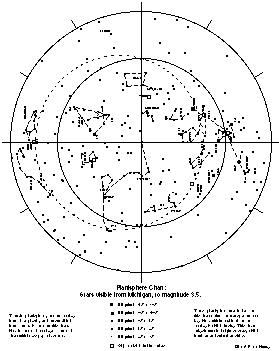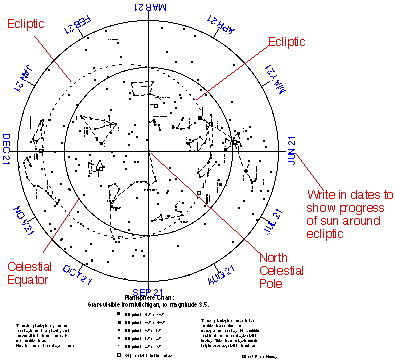The Planisphere
A planisphere is a tool for showing you what stars are visible at a given time and a given night. But it is also a tool for
improving your understanding of daily and annual motion. The planisphere has three parts: a star chart, a horizon overlay, and a brass fastener to hold the two together
Planisphere Chart
 |
The planisphere chart is a star chart centered on the North Celestial pole (All you Southern Hemisphere web surfers,
you'll need a chart centered on the South Celestial pole--sorry, but I haven't drawn one up). It shows all the sky that is
ever visible from Michigan. Only part of this chart is visible in the sky at any time.
The chart on this page is obviously too small to read.
This is scaled 2x oversize so you can print it half-size and fit it onto an 8.5" x 11" sheet of paper and still be able to read it. You will want to copy this onto cardstock at your local copy shop. The chart should be inside a perfect circle--if it
prints out as an oval, you'll have to rescale the chart with a graphics program.
The Ecliptic: The Path of the Sun
|
The center of the chart, where the two lines intersect, is the North Celestial pole. The star just off the intersection is Polaris, the North Star. The large solid circle within the chart is the Celestial Equator. The off-center dotted circle is the Ecliptic, the path of the sun. You will see four dates along the ecliptic--March 21, June 21, September 21, and December 21. These show the position of the sun along the ecliptic on each date. There are 12 little lines sticking out from the edge of the chart. Mark these dates off the ends of four of them. then fill in 8 more dates--Apr 21, May 21, Jul 21, Aug 21, Oct 21, Nov 21, Jan 21, and Feb 21--off the ends of the remaining lines. These tell you where the sun is on its path around the Ecliptic each month. Your chart should now look something like this. |
You have marked the sun's annual motion against the stars. The annual motion is caused by the Earth orbiting the Sun. As we travel around the Sun, we see it in different directions. Next we will mark the daily motion of the sun across the sky from east to west. Of course, this is caused by the Earth spinning on its axis, but we are dealing with appearances in the sky for now. We will mark daily or "Diurnal" motion on the Horizon Overlay
| You have marked the sun's annual motion against the stars. The annual motion is caused by the Earth orbiting the Sun. As we travel around the Sun, we see it in different directions. Next we will mark the daily motion of the sun across the sky from east to west. Of course, this is caused by the Earth spinning on its axis, but we are dealing with appearances in the sky for now. We will mark daily or "Diurnal" motion on the Horizon Overlay |  |
This is scaled 2x oversize so you can print it half-size and fit it onto an 8.5" x 11" sheet of paper and still be able to read it. You will have to copy this onto transparency material at your local copy shop. The overlay outline should be a perfect circle. The second-largest circle should exactly match the outer circle of the planisphere chart. If it does not match, or it prints out as an oval, you'll have to rescale the chart with a graphics program. The third-largest "circle" really is an oval. Again, if you can't get a decent printout, send me a self-addressed envelope.
| Cut out the overlay on the very largest circle. You will need to write in fin-tipped permanent marker between the 2 big circles. The oval inside the big circles represents the horizon. Everything inside the oval is visible, everything outside is below the horizon. The sun is at it's highest at solar noon (this may happen at a different clock time depending on your position in your time zone and whether Daylight Time is in effect. For instance in Southeast Michigan, solar noon is at 12:30 EST (winter) and 1:30 EDT (summer).). |  |
Ignoring those subtleties, sticking with solar time, the sun is due south at noon. Mark the short line closest to the horizon with "Noon". Mark between the two circles, but over the line. Now find the short line directly opposite the southern horizon, 12 hours away as "Midnight," or just "Mid." Since the sun rises in the East, the hours near the part of the horizon marked "East" are AM. Mark "6 AM" on the line 6 hours from noon and midnight on the east side. Then mark "6 PM" on the West side. You can figure out where to put the other hours.
The times on the transparent horizon overlay chart the motion of the sun from the east to the west. But the planisphere is not complete until you connect the two parts with a brass paper fastener. The tiny hole in the center of the overlay represents the North Celestial Pole. Run the fastener through it. Then stab it through the North Celestial Pole at the center of the chart, and fold the little doodads back on the fastener to hold the two sheets together. If you don't have any of those little brass fasteners around, you can resort to a little screw with a nut. You could even staple the chart to a bulletin board and hold the overlay on with a thumbtack.
Using the Planisphere
Match the time to the date. The stars inside the horizon oval are up. Those outside the oval aren't. To get a feel for the stars right overhead, hold the planisphere over your head, with North pointing North. To see what's up in the south. hold the planisphere with the southern horizon down, and face south (the chart itself may be upright, upside down, sideways or diagonal, depending on the time and date). To see what's up in the East, hold the eastern horizon down, and face East, and so forth.
Set the planisphere for 9:00 tonight. Notice the constellations that are up. Now move it to 10:00 tonight. Notice anything rise in the east? Set in the West? Keep going through the whole night. do you see the same constellations in the morning as in the evening? Do some constellations stay up all the time no matter how furiously you spin your planisphere? Compare the stars you see at 11:00 tonight to those visible at 9:00 one month from now. Makes you think, huh? 2 weeks of annual motion is sort of like 1 hour of daily motion.
Seasons
Sunrise is when the sun (on the ecliptic) is on the horizon. Check out sunrise and sunset on Mar 21, June 21, Sept 21, and December 21. Notice the times on sunrise and sunset. How many hours of daylight on each of these dates?
A tool and a toy for life
Your planisphere is a useful tool for aiding in finding constellations. It's always a handy device. You can buy commercial ones, too. They are often called "Star Finders" because "Planisphere" is too big a word for the commercial marketplace.
The times on the transparent horizon overlay chart the motion of the sun from the east to the west. But the planisphere is not complete until you connect the two parts with a brass paper fastener. The tiny hole in the center of the overlay represents the North Celestial Pole. Run the fastener through it. Then stab it through the North Celestial Pole at the center of the chart, and fold the little doodads back on the fastener to hold the two sheets together. If you don't have any of those little brass fasteners around, you can resort to a little screw with a nut. You could even staple the chart to a bulletin board and hold the overlay on with a thumbtack.
Using the Planisphere
Match the time to the date. The stars inside the horizon oval are up. Those outside the oval aren't. To get a feel for the stars right overhead, hold the planisphere over your head, with North pointing North. To see what's up in the south. hold the planisphere with the southern horizon down, and face south (the chart itself may be upright, upside down, sideways or diagonal, depending on the time and date). To see what's up in the East, hold the eastern horizon down, and face East, and so forth.
Set the planisphere for 9:00 tonight. Notice the constellations that are up. Now move it to 10:00 tonight. Notice anything rise in the east? Set in the West? Keep going through the whole night. do you see the same constellations in the morning as in the evening? Do some constellations stay up all the time no matter how furiously you spin your planisphere? Compare the stars you see at 11:00 tonight to those visible at 9:00 one month from now. Makes you think, huh? 2 weeks of annual motion is sort of like 1 hour of daily motion.
Seasons
Sunrise is when the sun (on the ecliptic) is on the horizon. Check out sunrise and sunset on Mar 21, June 21, Sept 21, and December 21. Notice the times on sunrise and sunset. How many hours of daylight on each of these dates?
A tool and a toy for life
Your planisphere is a useful tool for aiding in finding constellations. It's always a handy device. You can buy commercial ones, too. They are often called "Star Finders" because "Planisphere" is too big a word for the commercial marketplace.


